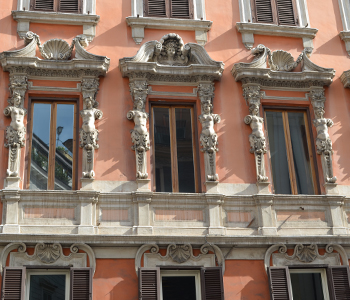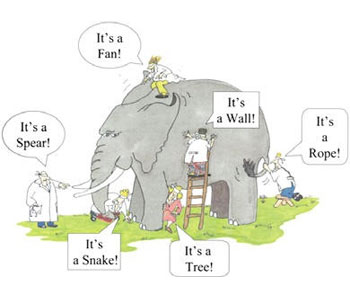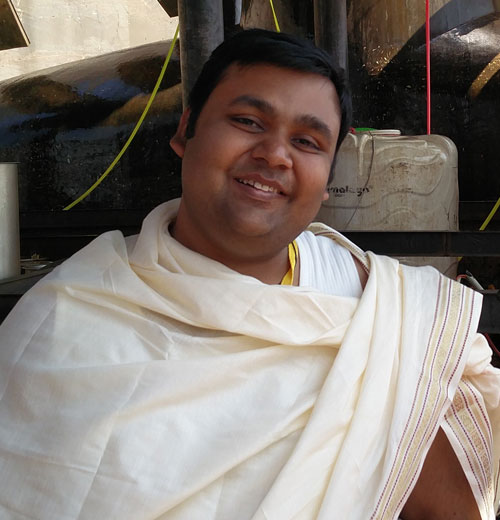Index
Disclaimer
This is just a point of view which is not claimed to be the absolute truth. In the work, I mean no harm to the sentiments of any religion or individual. If any of the word or phrase in this works hurts the feelings or beliefs of a person, I apologize for that in advance. I hope that this work will be accepted / rejected by readers in good faith / spirit and not as an attempt to create tensions among communities.Basis
The whole work is based on the philosophy of Anekantavada propagated by the twenty-forth and last Tirthankara of Jainism, Shri 1008 Mahavira Swami. The word Anekantavada means that there can be unlimited versions of perceiving a particular situation / statement. There’s no scope of any conflict between any two individuals if they see the things keeping in mind the principal of Anekantavada. The statement which is perceived to be the absolute truth by somebody might be perceived as the absolute lie by another and vice versa. For example, if you think that the glass is half filled with water, you are right. Another one who is saying the glass is half empty is also right. The third person and claims that the glass is full, half with water and half with air is also right. A person living in a hut might seem poor to the one living in a bungalow whereas he might seem rich to the one living on a footpath. Rains might be a problem to those who don’t like being wet but it’s a lifeline for most of the farmers in India. There are unlimited such examples which I can quote, so I am now going to use this principal to present my perspective of understanding few popular things and beliefs.Inspirations
Father
The first inspiration for this work of mine is my father. He was the first one who introduced me to this idea and how it can be used to understand some of the most complicated points of conflict quite easily. He first presented to me that how Shiva, Kali, Durga and Ganesha could be the graphical representation of certain thoughts and philosophies.Acharya Vishuddhasagar
- The second inspiration for this work of mine is the quote which I heard from Acharya Vishuddhasagar Ji in one his pravachans
- The quote was “Jo upmaye thi wo upmay ho gyi”.
- This means that what were meant to be symbols for conveying thoughts became thoughts or personalities in themselves.
- In modern days as well, creative teachers use various examples, figures and symbols to teach students certain topics.
- The powers or abilities are often compared with animals like as fast as a deer, as courageous as a lion, as faithful as a dog. None of them means that human is any of the mentioned animals. They are just used to help us understand certain things easily.
Chandragupta Maurya (TV Serial)
The last inspiration for this work is the TV series “Chandragupta Maurya” which was aired on Imagne TV. In that series, the Chanakya defeated Greeks using Chandragupta to make them believe that, “Maurya” is a God of the Indian lands and is very unhappy with Greeks invading and will unleash his wrath upon them and they will be demolished if they don’t leave India. The story is not the inspiration, but the power of writers like the one of Alexander to influence the minds of people and present history in their own ways. This inspires a thought, that it was not Chandragupta who defeated the Greeks but the fear of imaginary creation of Chanakya, the “Maurya”. This also clarifies that why in most of the royal histories kings are depicted as gods.Understanding the Shiva’s Image
- Shiva is one of the Tridevs in Hinduism and holds his own importance among Hindus. Let me use the philosophy of Anekantavada to decipher the Shiva's Image and present my thought of one of the possible ways in which he can be perceived in Jainism.
- Shiva is depicted as “Bhole” or the one who holds no attachments to world and is occupied most of the time in his own meditation. Similar is the depiction of Rishabhdev or Adinath, first Tirthankar in Jainism.
- Shiva’s weapon or tool is the Trishul. Trishul means three “shools” and shool means gyan. In Jainism as well, Adinath’s weapon or tool was trishul, i.e., Samyak Darshan, Samyak Gyan, Samyak Charitra. This trishul is referred as Ratantray in Jainism.
- Shiva is often depicted dancing (Tandava) and playing his damru. Dancing is perceived to be a great method of experiencing “Sukh” or happiness. Rishabhdev was also playing Damru of his Karma (demolishing Karma) and was enjoying the Anatasukha (Ultimate Happiness) of Kevalagyana.
- Third eye of Shiva is his inseparable identity which is explained to be the destroyer of the world. In Jainism as well third eye (of kevala gyan) is the destroyer of world (of own karmas).
- Nandi the Bull is the vehicle of Shiva. Bull is the symbol of Adinath.
- Ganga is said to have been brought to this world by Shiva in Hinduism. In Jainism as well, Ganga is said to enter this world from Gomukh after washing the feet of Rishabhdev.
- Shiva's disciples (Shivagana) are shown to be imitating him. Rishabha also had huge number of disciples imitating him to the path of moksha.
- Shiva is said to have demolished the poison by drinking it which made his throat blue. The greatest poison in Jainism is Anger and Jaleousy and if use little Hindi, “Gussa pee jana” is the only way to demolish or get rid of it. Blue is the color of cool or calm and one becomes absolutely cool after getting rid of anger.
- The Shiva and Parvati story to some extent resembles Neminath (twenty-second Tirthankar) and Rajul Story. Parvati is depicted as Shakti (Power) and Tirthankara is the Swami of ultimate power.
- Chandra on Shiva's might be percieved as the siddh-shila which lies above us.
Brahma
- Brahma in Jainism is the name of Rishabhdev or Adinath in Jainism.
- In hinduism Brahma is referred to as the creator of world, in Jainism, Adinath created the world by teaching people worldly deeds after Kalpavriksh got demolished at the beginning of fourth era (Chaturth-Kaal).
- Brahma's image is similar to depiction of a Tirthankar's Samavasarana.
- Brahma is shown seated on a Lotus in fact a little above, so is Tirthankar at the time of his Samavasarana.
- Brahma has four heads, one in each direction. Tirthankar also get's his image projected in all four directions by Devas during Samavasarana.
- Brahma holds Vedas in his hands which are the source of knowledge for hindus. Tirthankar also has Kevala Gyan in Samavasarana which is the ultimate knowledge in Jainism.
- Brahma's wife is Sarasvati (goddess of knowledge). Samavasarana of a Tirthankara is the knowledge source for laymen in Jainism.
- Brahma's vehicle is swan (bird) so is the symbol of Sumatinath, the fifth Tirthankara in Jainism.
- Brahma resides in Akasha, samavasarana is also in akasha.
Vishnu
- Vishnu sits on Shesh-Nag (snake) which covers his head as well. Similar is the depicted of Parshvanath (23rd Tirthankar) during Kamath's Upsarg.
- Vishnu lives in Sea, which is percieved to be endless. Kevala gyan, a state in which Tirthankar lives, is also sea of knowledge which is endless.
- Vishnu holds a vajra in one of his hands which s a symbol of Dharmanath, 15th Tirthankar n Jainism.
- Shankha in one of the Vishnu's hand is the symbol of Neminatha, 22nd Tirthankar.
- Sudarshan Chakra is weapon of Vishnu and his avatars in Hinduism. It is associated with Vasudev (Narayan) and Prativasudev (Pratinarayan) in Jainism.
- One of his head is of a lion, symbol of Mahavira, 24th Tirthankar.
- Another head is the boar, symbol of Vimalnath (13th Tirthankar).
- He is shown to be of great height in Mahabharata, all humans are shown of great height in fourth-era (Chaturth-Kaal), i.e., the time of Tirthankar in Jainism.
Ganesh
- Ganesh is the word for Ganadhar in Jainism.
- Ganesh has a head of elephant, which is percieved to be the most intelligent animal on earth. Ganadhar are all Kevalis in Jainism.
- Ganesh is vighna-harta (slayer of problems) so is Ganadhar by imparting Tirthankar's keval-gyan to laymen during samavasarana.
- Ganesh is worshipped along with Lakshmi in Diwali. Lakshmi in Jainism is Moksh, gandhar shows the path of moksh to laymen.
Note for the readers
I will be extending this work with the other perspective of some more depictions of mythology soon. Till then, I invite you all for expressing your thoughts in the comments (below) in favor or against the perception presented above and thank you for sparing some time from your busy schedule to give a reading to this.- Pankaj Jain






